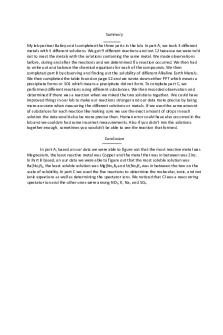Summary of electrophilic addition reactions PDF

| Title | Summary of electrophilic addition reactions |
|---|---|
| Author | reg sa |
| Course | Organic Chemistry I |
| Institution | Fitchburg State University |
| Pages | 2 |
| File Size | 85.8 KB |
| File Type | |
| Total Downloads | 2 |
| Total Views | 126 |
Summary
Download Summary of electrophilic addition reactions PDF
Description
Summary of electrophilic addition reactions
Type
Reagent
Product
HBr, HCl or HI
Alkyl halides with alkenes, vinyl halides with alkynes
Addition of water
H2O and H2SO4
Alcohols
Addition of halogens
Br2/organic solvent or Cl2/organic solvent
Addition of hydrogen halides
Oxymercurati on-reduction
Dibromo or dichloro alkanes with alkenes. With alkynes, the product is dibromo or dichloro alkenes. When an excess of halogen is used, the product is tetrabromo or tetrachloro alkanes Hg(O2CCH3 Alcohols with )2, H20 and alkenes, with NaBH4 alkynes the product is an enol. Enols are unstable and rearrange to either ketone or aldehyde
Markovn Syn/anti ikov’s rule Obey Both syn and anti products seen
obey
Obey
Obey
Both syn and anti products seen Only anti addition seen
Only anti addition seen
Special notes
With alkenes, the product is alkyl halide. In the case of alkynes, with one mole of HX, the product is vinyl halide(has a double bond), with two moles of HX, the product is dihalo substituted alkanes none
The reaction needs to be carried out in presence of organic solvents to get the dibromo or dichloro products. If the reaction is carried in the presence of water, the product is halohydrin as water acts as the nucleophile. When halohydrins are exposed to basic conditions, they form epoxides With alkenes, the product is alcohol, with alkynes the product is enol which rearranges to ketone or aldehyde depending on the type of alkyne
Hydroboration
BH3/H2O2 or disiamylbora ne/H2O2
Hydroxylation
KMnO4
Hydrogenatio n
H2 in presence of hydrogenatio n catalysts such as Pd, Pt, Ni, PtO2
Alcohols with alkenes. In the case of alkynes, the product is enol, which rearranges to either aldehyde or ketone Diol Alkanes with alkenes
Do not obey
Only syn addition is seen
This is the only addition reaction we have seen, where Markovnikov’s rule is not obeyed and the reaction proceeds via only syn addition
Not important NA
NA
None
Syn
When hydrogenation of alkynes is carried out in presence of H2 and regular hydrogenation catalysts, the product is alkane. This reaction does not stop at the alkene stage. However, if we wish to stop at the alkene stage, we need to use a special catalyst called Lindlar’s catalyst...
Similar Free PDFs

Electrophilic Bromination
- 3 Pages

Rates of Chemical Reactions
- 9 Pages

Types of chemical reactions
- 4 Pages

Reactions of Alkynes KEY
- 14 Pages
Popular Institutions
- Tinajero National High School - Annex
- Politeknik Caltex Riau
- Yokohama City University
- SGT University
- University of Al-Qadisiyah
- Divine Word College of Vigan
- Techniek College Rotterdam
- Universidade de Santiago
- Universiti Teknologi MARA Cawangan Johor Kampus Pasir Gudang
- Poltekkes Kemenkes Yogyakarta
- Baguio City National High School
- Colegio san marcos
- preparatoria uno
- Centro de Bachillerato Tecnológico Industrial y de Servicios No. 107
- Dalian Maritime University
- Quang Trung Secondary School
- Colegio Tecnológico en Informática
- Corporación Regional de Educación Superior
- Grupo CEDVA
- Dar Al Uloom University
- Centro de Estudios Preuniversitarios de la Universidad Nacional de Ingeniería
- 上智大学
- Aakash International School, Nuna Majara
- San Felipe Neri Catholic School
- Kang Chiao International School - New Taipei City
- Misamis Occidental National High School
- Institución Educativa Escuela Normal Juan Ladrilleros
- Kolehiyo ng Pantukan
- Batanes State College
- Instituto Continental
- Sekolah Menengah Kejuruan Kesehatan Kaltara (Tarakan)
- Colegio de La Inmaculada Concepcion - Cebu











